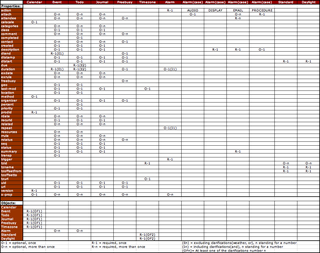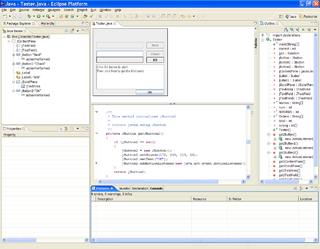Related Research Articles

Letterboxing is the practice of transferring film shot in a widescreen aspect ratio to standard-width video formats while preserving the film's original aspect ratio. The resulting videographic image has mattes above and below it; these mattes are part of the image. LBX or LTBX are the identifying abbreviations for films and images so formatted.

Lotus 1-2-3 is a discontinued spreadsheet program from Lotus Software. It was the IBM PC's first killer application, was hugely popular in the 1980s and contributed significantly to the success of the IBM PC.

Microsoft Access is a database management system (DBMS) from Microsoft that combines the relational Microsoft Jet Database Engine with a graphical user interface and software-development tools. It is a member of the Microsoft Office suite of applications, included in the Professional and higher editions or sold separately.
A spreadsheet is a computer application for organization, analysis and storage of data in tabular form. Spreadsheets were developed as computerized analogs of paper accounting worksheets. The program operates on data entered in cells of a table. Each cell may contain either numeric or text data, or the results of formulas that automatically calculate and display a value based on the contents of other cells. A spreadsheet may also refer to one such electronic document.
HCL Notes and HCL Domino are the client and server, respectively, of a collaborative client-server software platform formerly sold by IBM, now by HCL Technologies.
A video card is an expansion card which generates a feed of output images to a display device. Frequently, these are advertised as discrete or dedicated graphics cards, emphasizing the distinction between these and integrated graphics. At the core of both is the graphics processing unit (GPU), which is the main part that does the actual computations, but should not be confused with the video card as a whole, although "GPU" is often used to refer to video cards.
In computing, Open Database Connectivity (ODBC) is a standard application programming interface (API) for accessing database management systems (DBMS). The designers of ODBC aimed to make it independent of database systems and operating systems. An application written using ODBC can be ported to other platforms, both on the client and server side, with few changes to the data access code.
The Microsoft Windows Script Host (WSH) is an automation technology for Microsoft Windows operating systems that provides scripting abilities comparable to batch files, but with a wider range of supported features. This tool was first provided on Windows 95 after Build 950a on the installation discs as an optional installation configurable and installable by means of the Control Panel, and then a standard component of Windows 98 and subsequent and Windows NT 4.0 Build 1381 and by means of Service Pack 4. The WSH is also a means of automation for Internet Explorer via the installed WSH engines from IE Version 3.0 onwards; at this time VBScript became means of automation for Microsoft Outlook 97. The WSH is also an optional install provided with a VBScript and JScript engine for Windows CE 3.0 and following and some third-party engines including Rexx and other forms of Basic are also available.

The Internet Calendaring and Scheduling Core Object Specification (iCalendar) is a MIME type which allows users to store and exchange calendaring and scheduling information such as events, to-dos, journal entries, and free/busy information. Files formatted according to the specification usually have an extension of .ics. With supporting software, such as an email reader or calendar application, recipients of an iCalendar data file can respond to the sender easily or counter-propose another meeting date/time. The file format is specified in a proposed internet standard for calendar data exchange.

The Standard Widget Toolkit (SWT) is a graphical widget toolkit for use with the Java platform. It was originally developed by Stephen Northover at IBM and is now maintained by the Eclipse Foundation in tandem with the Eclipse IDE. It is an alternative to the Abstract Window Toolkit (AWT) and Swing Java graphical user interface (GUI) toolkits provided by Sun Microsystems as part of the Java Platform, Standard Edition (J2SE).
Oracle Application Express is a web-based software development environment that runs on an Oracle database. It is fully supported and comes standard with all Oracle Database editions and, starting with Oracle 11g, is installed by default as part of the core database install.

Google Desktop was a computer program with desktop search capabilities, created by Google for Linux, Apple Mac OS X, and Microsoft Windows systems. It allowed text searches of a user's email messages, computer files, music, photos, chats, Web pages viewed, and the ability to display "Google Gadgets" on the user's desktop in a Sidebar.
cc:Mail was a store-and-forward LAN-based email system originally developed on Microsoft's MS-DOS platform by Concentric Systems, Inc. in the 1980s. The company, founded by Robert Plummer, Hubert Lipinski, and Michael Palmer, later changed its name to PCC Systems, Inc., and then to cc:Mail, Inc. At the height of its popularity, cc:Mail had about 14 million users, and won various awards for being the top email software package of the mid-1990s.

Visual Basic is a third-generation event-driven programming language from Microsoft for its Component Object Model (COM) programming model first released in 1991 and declared legacy during 2008. Microsoft intended Visual Basic to be relatively easy to learn and use. Visual Basic was derived from BASIC and enables the rapid application development (RAD) of graphical user interface (GUI) applications, access to databases using Data Access Objects, Remote Data Objects, or ActiveX Data Objects, and creation of ActiveX controls and objects.
Omnipeek is a packet analyzer software tool from Savvius, a LiveAction company, for network troubleshooting and protocol analysis. It supports an application programming interface (API) for plugins.

Oracle SQL Developer is an Integrated development environment (IDE) for working with SQL in Oracle databases. Oracle Corporation provides this product free; it uses the Java Development Kit.
Pervasive PSQL is an ACID-compliant database management system (DBMS) developed by Pervasive Software. It is optimized for embedding in applications and used in several different types of packaged software applications offered by independent software vendors (ISVs) and original equipment manufacturers (OEMs). It is available for software as a service (SaaS) deployment due to a file-based architecture enabling partitioning of data for multitenancy needs.

Redmi is a sub-brand owned by the Chinese electronics company Xiaomi. It was first announced in July 2013 as a budget smartphone line, and became a separate sub-brand of Xiaomi in 2019 with entry-level and mid-range devices, while Xiaomi itself produces upper-range and flagship Mi phones. Redmi phones use the Xiaomi MIUI user interface on top of Android. Models can be divided into the entry-level Redmi phones with display usually up to 6" and the mid-range Redmi Note series with displays exceeding 5" and equipped with higher-end specifications. The low-end Redmi A series and Redmi Go have been marketed in several Asian and European countries. The most significant difference from other Xiaomi smartphones is that they use less-expensive components and thus have lower prices with reduced specification. In August 2014, The Wall Street Journal reported that in the second quarter of the 2014 fiscal year, Xiaomi had a market share of 14% of smartphone shipment rankings in China. Redmi sales were attributed as a contributing factor toward this gain in shipment rankings.
The Lotus International Character Set (LICS) is a proprietary single-byte character encoding introduced in 1985 by Lotus Development Corporation. It is based on the 1983 DEC Multinational Character Set (MCS) for VT220 terminals. As such, LICS is also similar to two other descendants of MCS, the ECMA-94 character set of 1985 and the ISO 8859-1 (Latin-1) character set of 1987.

The Xiaomi Redmi Note 4 is the fourth smartphone under the Redmi Note series developed by Xiaomi Inc. It is a part of Xiaomi's budget Redmi smartphone lineup. It has two variants : The older version sold as Redmi Note 4 is powered by a Deca-core Mediatek MT6797 Helio X20 SOC. The upgraded version, sold both as Redmi Note 4X and Redmi Note 4 is powered by an Octa-core MSM8953 Qualcomm Snapdragon 625 SoC. The Redmi Note 4 was succeeded by Redmi Note 5.
References
- ↑ "NotesPeek: X-ray vision into Notes databases". www.ibm.com. 1998-07-01. Retrieved 2017-09-07.
- ↑ Neilson, Greg (2000). Lotus Domino Administration in a Nutshell: A Desktop Quick Reference. "O'Reilly Media, Inc.". ISBN 9781565927179.